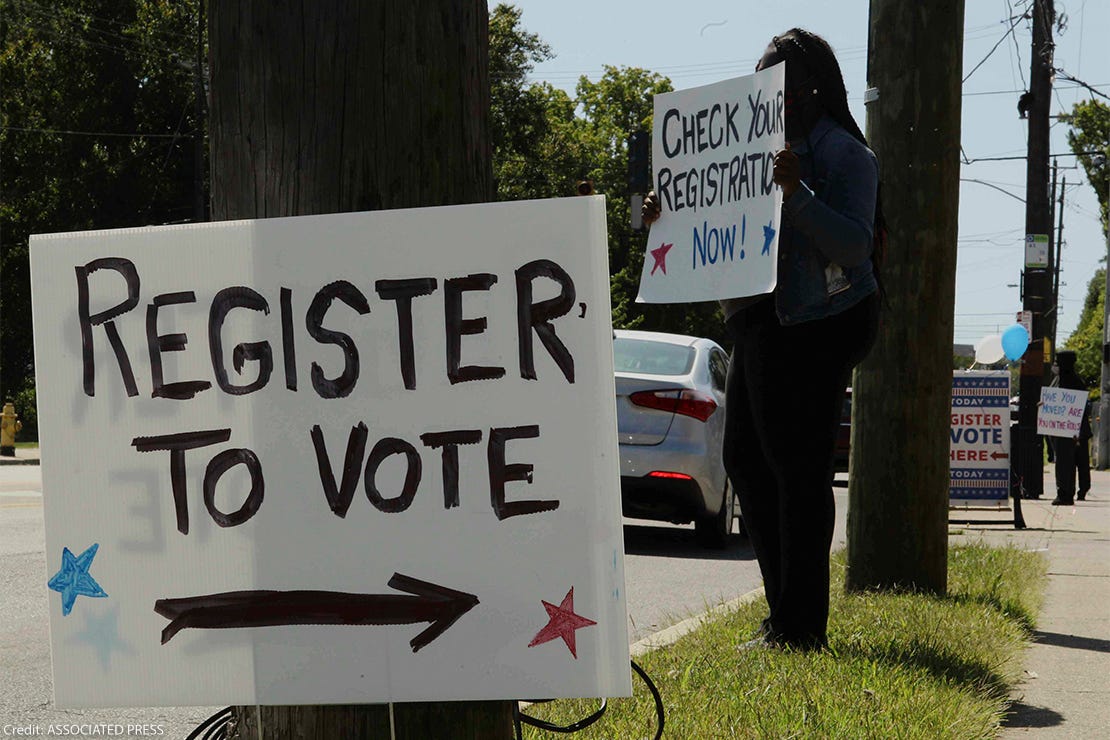By Steve Schear
When I was eight years old, visiting the science museum in Dayton, Ohio, I saw a bust of a man with a giant head. This, the description said, is how we will look in the future, once our species evolves to have massive brains. Here was a creature three times as intelligent as the rest of us, with a smile on his face.
More recently, at the Museo of Antropologia in Mexico City, I learned that evolution from Homo Ergaster to Homo Sapiens took 1.5 million years. Homo Sapiens have only been around about 300,000 years. We haven’t yet come close to becoming that supersmart species portrayed by the bust.
Realizing that we have not evolved into a purely rational species can help us understand the situation we are in. Our organizing must take into account the power of emotions on both ourselves and others.
Their Strength and Ours
We must not underestimate the challenge we now face. MAGA controls the government and a majority of the media. It has virtually unlimited financial resources due to billionaires like Elon Musk, who are willing to finance MAGA in exchange for power and making even more money. This election, with Trump winning 2.5 million more votes than in 2020, and Harris receiving 6 million fewer than Biden, shows that MAGA is winning the battle for voters’ hearts and minds.
Yet we should not underestimate our own power and capacities. Trump’s victory margin was only 1.5 percent and he did not win a majority of the popular vote. So nearly half the voting public is on our side. Hundreds of thousands volunteered to help Harris and other Democrats.
Although we lost all the swing states, Harris was defeated by much narrower margins in those states than in others. The combination of canvassers and media campaigns did move voters to our side, though obviously not enough.
Emotionally Intelligent Organizing
How can grassroots volunteers help reverse MAGA momentum and start building our own?
1. We need to continue the work in 2025 and have fun doing it.
One of the great things about the 2024 campaigns was the number and quality of the volunteers. The more who stay active, the better our chances of defeating MAGA. Lots of us are understandably feeling worn out and dispirited. If that’s you, take a break, and indulge your PENA (Post-Election News Aversion) if you have it. But we’ll need you back next year, because we are now in a more difficult position than before. A big drop in volunteer energy will lead to more electoral losses in 2026.
It's not realistic to think that tens of thousands of people will continue to do political work if it feels like a drudge. So we need to make a movement that is creative, lively, and fun. How? Traveling to do political work is one easy way, because volunteers can combine activism with enjoying local culture and nature. When I was in Montana canvassing for Jon Tester, I went rafting on the Yellowstone River, saw bald eagles in the wild, and got to raft through whitewater on a beautiful sunny day. It was one of the best experiences of my life.
A wonderful way to recruit volunteers, raise money, and have fun at the same time is to have parties. Neighborhood parties were the primary way the Mecklenburg County NC Dems increased their volunteers from 20 to nearly 3,000 in just 16 months. Meck Dem T-shirts read: “Join the Party”. By thinking creatively and working with others, we can make political work fun enough to keep the positive energy flowing.
2. Teach about the right-wing propaganda machine (RWPM)
While canvassing in October, I talked to a middle-class guy in Livingston, MT, who works in the health industry. He followed the news but was not that political. He told me he supported Trump, then started repeating RWPM lies. After listening for 10 minutes, I started talking about the RWPM, maintaining at all times a very friendly and warm attitude. As an example of the lies he was being told, I mentioned something he said about oil production. Then I talked about why Fox had to pay Dominion Voting Systems $787 million for defamation. After that, I gave him lots of examples of how the RWPM takes a sliver of truth and turns it into a lie. When I got a little passionate, I made fun of myself for not keeping my cool. We talked for about 40 minutes, and I could tell by the end that that he was open to the possibility that he was being lied to. We both really enjoyed the discussion, because it was emotionally warm.
Talking to both Republicans, independents and non-voters, we need to frontally attack the RWPM while maintaining a warm and friendly approach. We also need to encourage political leaders and candidates, podcasters and influencers, to do the same. We need people to understand that they are being lied to.
Jodie Levin-Epstein, a Bay Area organizer, has proposed a conference to discuss how to combat the RWPM, an excellent idea. If you would be interested in helping to organize such a Zoom conference, let me know at steveschear@gmail.com.
3. Developing local leadership
Organizing with emotional intelligence goes beyond our own communications with others. We also need to focus on who is delivering the messages. Trust is essential for persuasion. People have more trust in people they know. Recognition of this truism led the Biden campaign to emphasize relational organizing to friends and family using its REACH app. However, because of polarization, it is unrealistic to expect relational organizing by Democrats among friends and families to reach large numbers of MAGA supporters or non-voters.
At the same time, the absence of relationships was one of the reasons our tens of thousands of canvassers had less of an impact than we had hoped. A single conversation with a stranger at the door is unlikely to persuade a Republican or non-voter to vote for Democrats.
Canvassing is effective at motivating Democrats to vote, but it is less useful for more difficult persuasion efforts. People have developed their world views over a long period of time. You can plant seeds that may lead to change, but with rare exceptions, it is not realistic to expect to flip Republicans or non-voters in a single conversation at the door.
That’s why we should focus on developing local leadership in purple and red states. We need people who can and will talk to their neighbors more than once. Unfortunately, there are few strong county and state Democratic parties. Most are underfunded and understaffed. Grassroots organizations are far stronger in blue states than elsewhere. As a result, strong local leadership is a rarity where we need it most, in red and purple states.
But there are Democrats everywhere. Even in deep red parts of the country, Democrats typically get a third of the vote. We need to find and help local Dems organize in red and purple places. It will take a different kind of emotional intelligence to recruit, inspire and work with local leaders. Potential Dem leaders living within red cultures may feel beleaguered and defeated (especially after the 2024 election results.) We can use warmth, humor and offers of support to encourage potential leaders to step up.
We can work with local county Democratic parties, or with local chapters of national organizations like Indivisible or Swing Left, or with local organizations, depending on where we can find people with a capacity to lead effectively.
4. Strategies for Moving Forward
Other ideas about what we should do to combat the RWPM are still under construction, but here are brief descriptions of some of mine. I’ll write more about these and other ideas in future articles.
Better Training of Ourselves and Others
Of the tens of thousands of canvassers in the field this year, most received little training on how to canvass effectively, and no training at all how to talk to non-voters or Republicans. I doubt anyone received training on how to expose the RWPM. We need better training so that we can both organize more effectively and teach local organizers effective techniques to apply to local conditions. For example, the Meck Dems’ strategy of throwing neighborhood parties is easily replicated.
Learning How to Register Democrats
I first realized that we might be in trouble this year last spring, when I learned that the Republicans were far ahead in new registrations in most states. There are approximately 90 million eligible non-voters, more than Republican or Democratic voters. We need to spend some serious effort on figuring out how we can turn non-voters into Democrats. This is no easy task. Non-voters often have strong feelings of cynicism, distrust, disgust or anger directed at politicians, politics or the government. One idea is to use Trump administration actions that hurt people, like Medicaid cutbacks or increases in food prices due to tariffs, to show people that who runs the government does matter. It may be possible to turn non-voters’ negative feelings about what is going on in this country against MAGA, now that it holds power over the federal government.
Helping Local Organizers in Purple and Red Places
We can relatively easily identify strategic places where increasing Dem votes will help us gain more power. These include: competitive congressional races, states where we can flip a state legislative chamber, eliminate a GOP supermajority, or win a governorship or state supreme court race. We can research where organizing is needed and find the most promising local leaders and organizations that we can help. We should especially focus on building Democratic county parties where feasible. We can raise money for organizations, provide remote technical or phonebanking assistance, and send in organizers when they are needed and welcome.
This concept is similar to the Sister District Project. However, instead of focusing on funding candidate campaigns, it would help build lasting local organizations that can do community events, persuasion and GOTV year after year.
I welcome your feedback on these ideas. Please put them in the comments section so others can see them, too. If you have your own ideas, those are welcome, too.








Thank you for recognizing Meck Dems! As a Precinct chair here in Huntersville, the strategy of planning social get-togethers to build community and attract volunteers worked! We also grouped precincts geographically to work together vs in isolation. We were able to flip the town board and Mayor to blue in 2023 with this approach as well as running a strong slate of candidates. I absolutely agree figuring out how to outmaneuver the RW media will be absolutely critical moving forward. It's the single biggest thing I'm worried about.
I agree with all your suggestions about moving forward. I am particularly interested in keeping volunteers engaged. I was afraid that everyone would step away after Nov 5, but instead I am finding new people, especially younger (than me!) people and people who have never taken action before. Where I live, in Durham NC, there are several new activist groups just getting started and others are getting new volunteers. Channeling that energy will be important so that people can feel that there is a way forward. I have held trainings with volunteers about how to engage voters in real conversations, but would welcome more skill-building about how to engage people too discouraged about government to participate. I think this alongside training people to counteract the lies they are hearing would be a good combination. I'm down with that!
Anyone else in NC (I'm in Durham), please let me know!